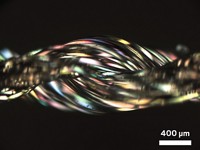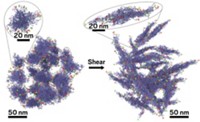Advertisement
Grab your lab coat. Let's get started
Welcome!
Welcome!
Create an account below to get 6 C&EN articles per month, receive newsletters and more - all free.
It seems this is your first time logging in online. Please enter the following information to continue.
As an ACS member you automatically get access to this site. All we need is few more details to create your reading experience.
Not you? Sign in with a different account.
Not you? Sign in with a different account.
ERROR 1
ERROR 1
ERROR 2
ERROR 2
ERROR 2
ERROR 2
ERROR 2
Password and Confirm password must match.
If you have an ACS member number, please enter it here so we can link this account to your membership. (optional)
ERROR 2
ACS values your privacy. By submitting your information, you are gaining access to C&EN and subscribing to our weekly newsletter. We use the information you provide to make your reading experience better, and we will never sell your data to third party members.
Nanomaterials
Mimicking nonstick spiders
Inspired by spider legs, researchers make nanoscopic structures that don’t get caught up in structural stickiness
by Matt Davenport
April 5, 2020
| A version of this story appeared in
Volume 98, Issue 13

Spiders are giving humans a hand (rather, a leg) when geckos get us into sticky situations. Researchers have long known that engineered micro- and nanostructures that mimic gecko feet can make surfaces supersticky. But what to do when surfaces shouldn’t stick to something, say tools or processing equipment? Anna-Christin Joel of Aachen University realized that cribellate spiders have a solution to this problem. The webs of these spiders derive their stickiness from structure—a wool-like coating of silk nanofibers—rather than protein glues. Tiny comb-like structures called calamistra on the spiders’ legs are able to fluff up this silk without sticking to it.
Working with Werner Baumgartner of Johannes Kepler University Linz, Joel and her team showed that the geometry of calamistrum ripples (shown) minimize van der Waals interactions and, thus, adhesion with the nanofibrous silk. The team took this information a step further, using laser light to create ridges in polymer films to emulate calamistra. They showed that modified films adhered less to cribellate spider silk than the native polymer (ACS Appl. Nano Mater.2020, DOI: 10.1021/acsanm.0c00130). Such surfaces could be useful for handling and processing electrospun nanofibrous threads employed in filtration, Joel says.




Join the conversation
Contact the reporter
Submit a Letter to the Editor for publication
Engage with us on Twitter